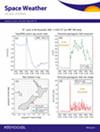An Examination of Geomagnetic Induction in Submarine Cables
IF 3.7
2区 地球科学
引用次数: 0
Abstract
Submarine cables have experienced problems during extreme geomagnetic disturbances because of geomagnetically induced voltages adding or subtracting from the power feed to the repeaters. This is still a concern for modern fiber-optic cables because they contain a copper conductor to carry power to the repeaters. This paper provides a new examination of geomagnetic induction in submarine cables and makes calculations of the voltages experienced by the TAT-8 trans-Atlantic submarine cable during the March 1989 magnetic storm. It is shown that the cable itself experiences an induced electromotive force (emf) and that induction in the ocean also leads to changes of potential of the land at each end of the cable. The process for calculating the electric fields induced in the sea and in the cable from knowledge of the seawater depth and conductivity and subsea conductivity is explained. The cable route is divided into 9 sections and the seafloor electric field is calculated for each section. These are combined to give the total induced emf in the cable. In addition, induction in the seawater and leakage of induced currents through the underlying resistive layers are modeled using a transmission line model of the ocean and underlying layers to determine the change in Earth potentials at the cable ends. The induced emf in the cable and the end potentials are then combined to give the total voltage change experienced by the cable power feed equipment. This gives results very close to those recorded on the TAT-8 cable in March 1989.对海底电缆地磁感应的研究
在极端地磁干扰期间,海底电缆会出现问题,因为地磁引起的电压会增加或减少中继器的馈电。这仍然是现代光导纤维所担心的问题,因为光导纤维中含有向中继器馈电的铜导体。本文对海底电缆中的地磁感应进行了新的研究,并对 TAT-8 跨大西洋海底电缆在 1989 年 3 月磁暴期间经历的电压进行了计算。结果表明,电缆本身经历了感应电动势 (emf),海洋中的感应也导致电缆两端陆地电势的变化。说明了根据海水深度和电导率以及海底电导率计算海洋和电缆中感应电场的过程。电缆线路被分为 9 段,每段的海底电场都会计算出来。将这些数据结合起来,就得出了电缆中的总感应电场。此外,利用海洋和底层的传输线模型对海水中的感应和通过底层电阻层的感应电流泄漏进行建模,以确定电缆两端地球电位的变化。然后将电缆中的感应电势和末端电势结合起来,得出电缆馈电设备所经历的总电压变化。这样得出的结果与 1989 年 3 月在 TAT-8 号电缆上记录的结果非常接近。
本文章由计算机程序翻译,如有差异,请以英文原文为准。
求助全文
约1分钟内获得全文
求助全文

 求助内容:
求助内容: 应助结果提醒方式:
应助结果提醒方式:


